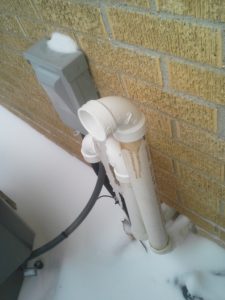The first snow storm of the season hit this past weekend, and as the snow starts to drift against your house, homeowners with high-efficiency furnaces should make sure their fresh air intake and exhaust pipes are free of snow. They’re usually white plastic pipes that come out of the side of a home. A blocked intake pipe or exhaust vent could result in carbon monoxide poisoning. The same is true for dryer vents. Check vents frequently during periods of heavy or blowing snow.

Fresh air intake and exhaust pipes are usually white plastic pipes that come out of the side of a home.
Carbon monoxide gas is produced by the incomplete burning of fuels. It can be released by gas furnaces, hot water heaters, cars, fireplaces, wood stoves and kerosene heaters. Faulty burners or clogged chimneys are often part of the problem. To avoid the production of CO, you should have your chimney, furnace and gas-fired appliances checked by professional technicians every year.

Smoke and carbon monoxide detectors need regular cleaning to ensure dust doesn’t build up and interfere with the sensors.
To reduce the chances of you or a loved one getting carbon monoxide poisoning, follow these tips:
1. Eliminate CO at the source. Make the maintenance of your furnace, fireplace, and all fuel-burning appliances an absolute priority. Have them checked and cleaned each year.
2. Install a certified carbon monoxide alarm in your home and check it regularly to make sure the battery is working.

During winter snow storms, be sure drifting snow does not cover your furnace intake and exhaust vents.
4. Never heat your home with a gas stove.
5. Never use a BBQ, charcoal or hibachi grill in the home or in an enclosed area.
6. During and after a snowstorm, make sure vents for the dryer, furnace, stove and fireplace are clear of snow.
7. Never use a gas-powered generator inside your home.
8. If your CO alarm sounds, make sure to get out of your home immediately and call 911 from a safe place.
THE 905 REAL ESTATE GUYS
info@905realestateguys.com
Sean Kavanagh 905.220.9198
Leo Manchisi 905.334.9650

